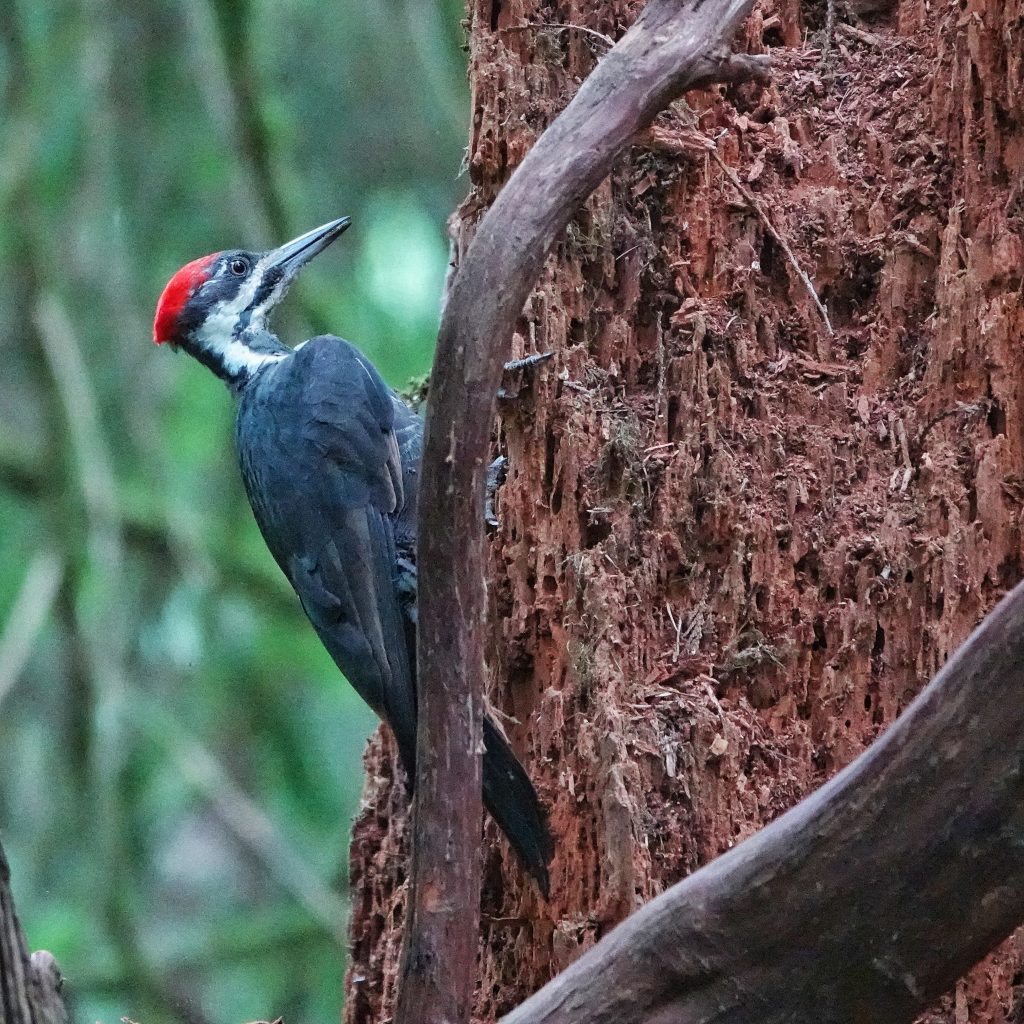
I am always excited to find any of the woodpeckers (including flickers and sapsuckers) and Picadae is probably my favorite family of birds. There is something about hammering their beak against solid objects that just thrills the Neanderthal in me. Couple that with their relatively large size (even the little Downy Woodpeckers are bigger than most sparrows), bold patterning, and the fact that I immediately notice the rhythmic sound of their drilling much more than I notice birdsong (possibly because it’s a lower frequency than most birdsong and my higher frequency hearing is mostly shot), hear them more often than I see them, and don’t hear them very often (unless I’m watching a tv show or movie that has any outdoor scenes-you’d think woodpeckers were ubiquitous if you judged by the frequency with which you hear drumming any time the scene is set in nature), and you can understand why I really perk up when there are woodpeckers about.
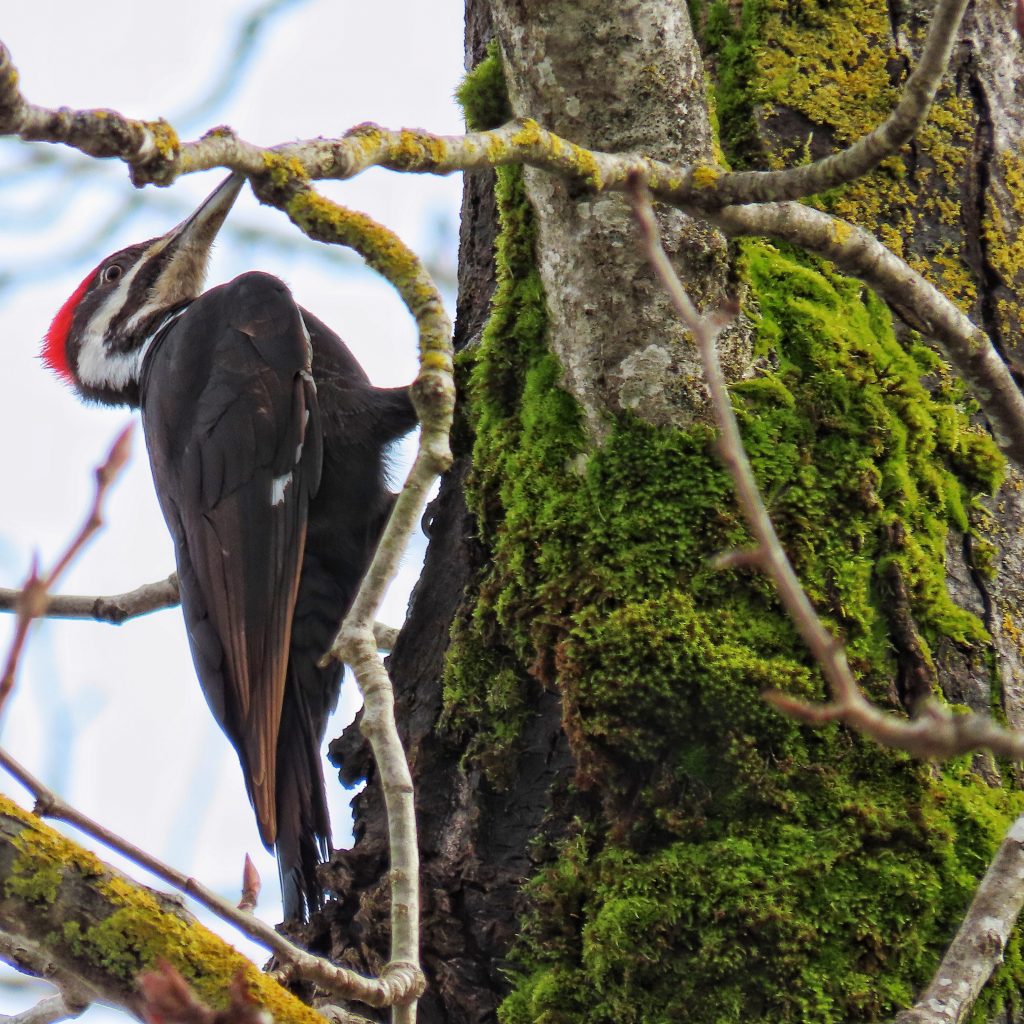
And of them all, the Pileated is the king, at least in North America! At up to 19” tall it is, with the probable extirpation of the Ivory-billed Woodpeckers, the largest woodpecker in North America. In the deep woods where I usually see them their black body is often lost in shadow, so that my first view of them is just a blur of black, white, and red head jackhammering into a tree. Then there is that call that sounds like maniacal laughter, and always makes me feel that I’m in a prehistoric jungle (apparently the cartoonist Walter Lantz based the appearance of Woody Woodpecker on Pileated Woodpeckers, although the call was taken from Acorn Woodpeckers). This was the first time I’d ever seen Pileateds in the area I call the Pristine Forest, near Brush Prairie, Washington, and judging by the lack of even blurry photos, possibly the first time I’d seen the species at all since an encounter on the Sandy River in Oregon in February of 2021. And, as usual, the high point of that day.
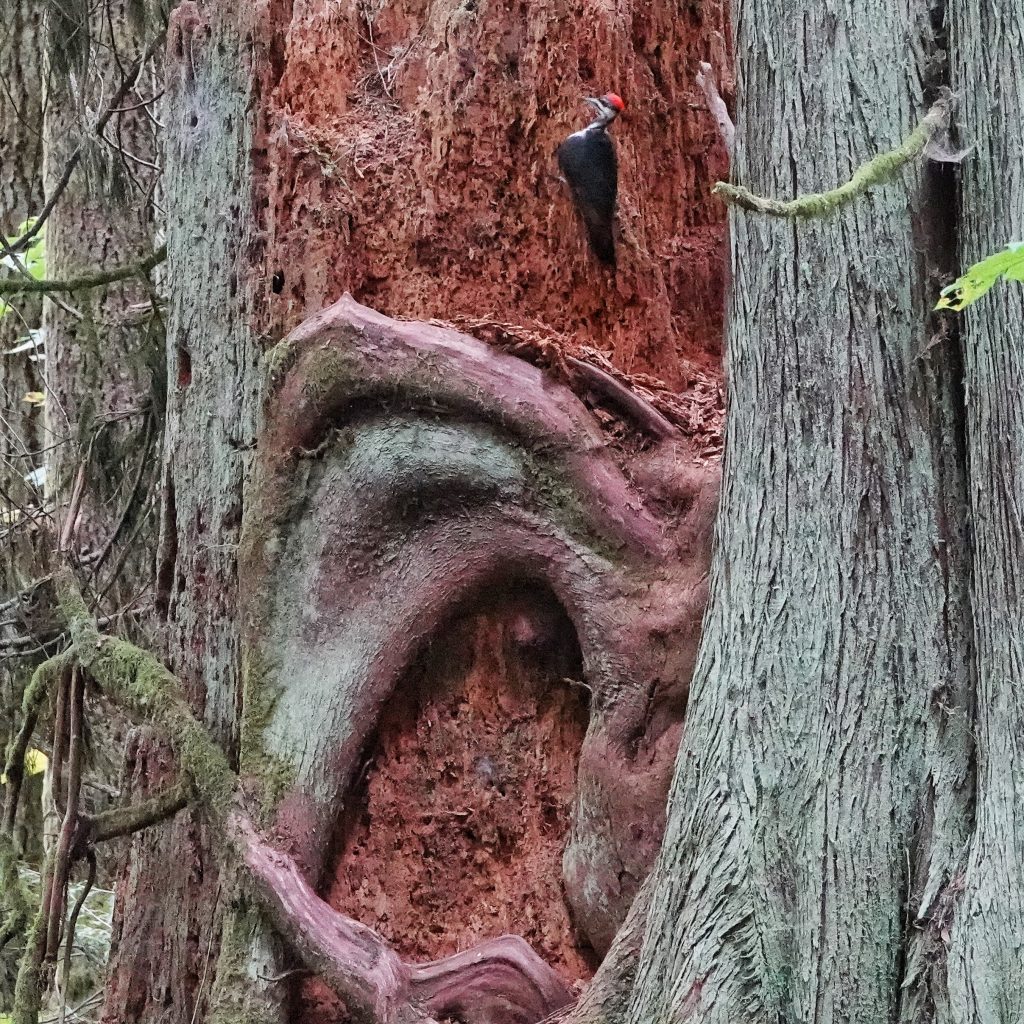
Dryocopus pileatus (and woodpeckers in general) have interesting adaptations for a life of banging their beak against a tree in search of potential invertebrates living in its interior. For one thing their tongue wraps around the skull and anchors between their eyes, thus providing some cushioning for their brain. The tongue is barbed, and coated with sticky saliva, which both enhance its ability to extract the ants and grubs on which the bird feeds. Another adaptation is that they have a reduced amount of fluid surrounding their brain so that it can’t ‘slosh’ very far, as well as the brain being oriented to spread the force over a larger area. They also have a self sharpening, chisel-like bill that penetrates rather than stops abruptly, and strong neck muscles to absorb the shock.
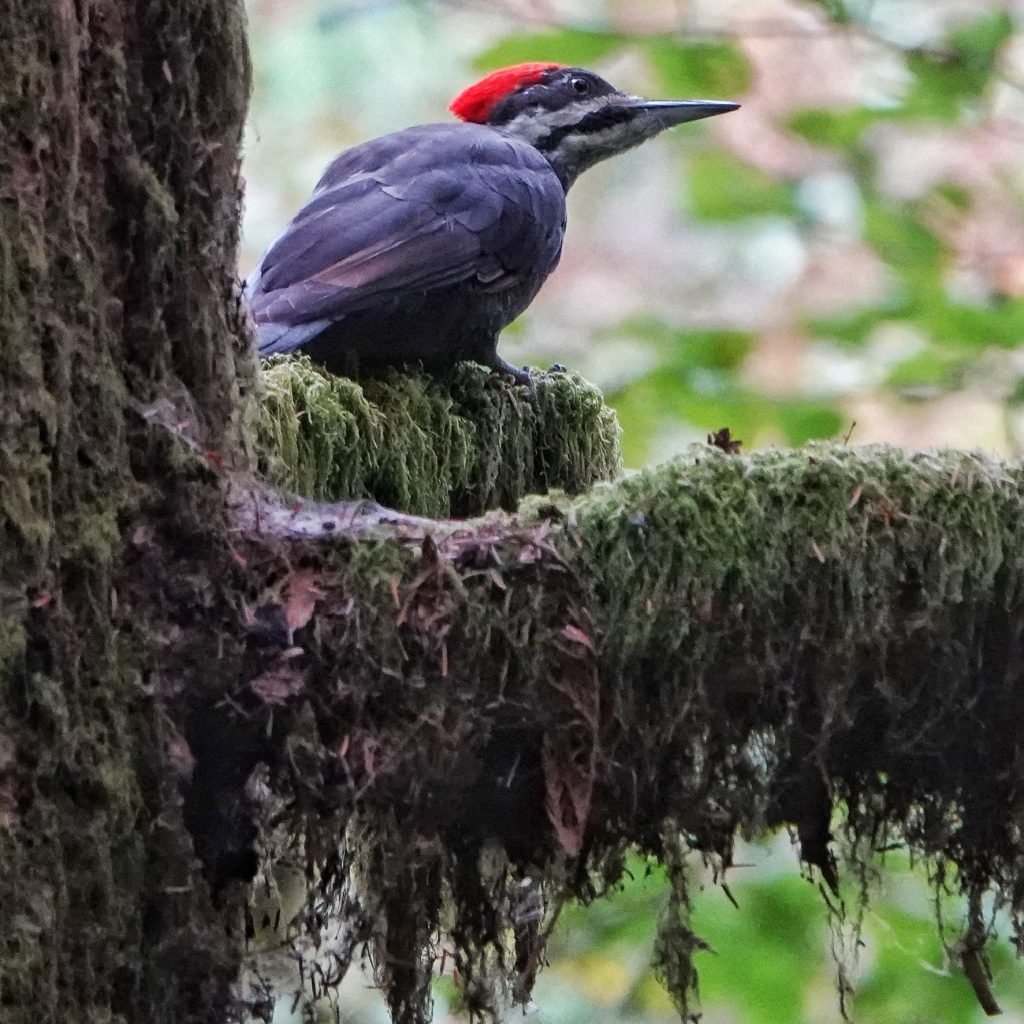
Despite the fact that they mate for life, females are still courted by their mate each spring. Courtship involves bowing, head swinging, drumming, and a dance that includes stepping sideways in a circle around the female while doing wing spreading displays. The parents work together to excavate the nest, incubate the eggs, and feed the young, and they continue their parental duties for several months after the chicks have fledged. For this reason they only rear one brood per year. They are non-migratory and very territorial birds, at least in spring, summer, and fall, and will defend territories as large as a thousand acres. But they relax a bit once the young are reared, and don’t automatically drive off intruders in the winter months.
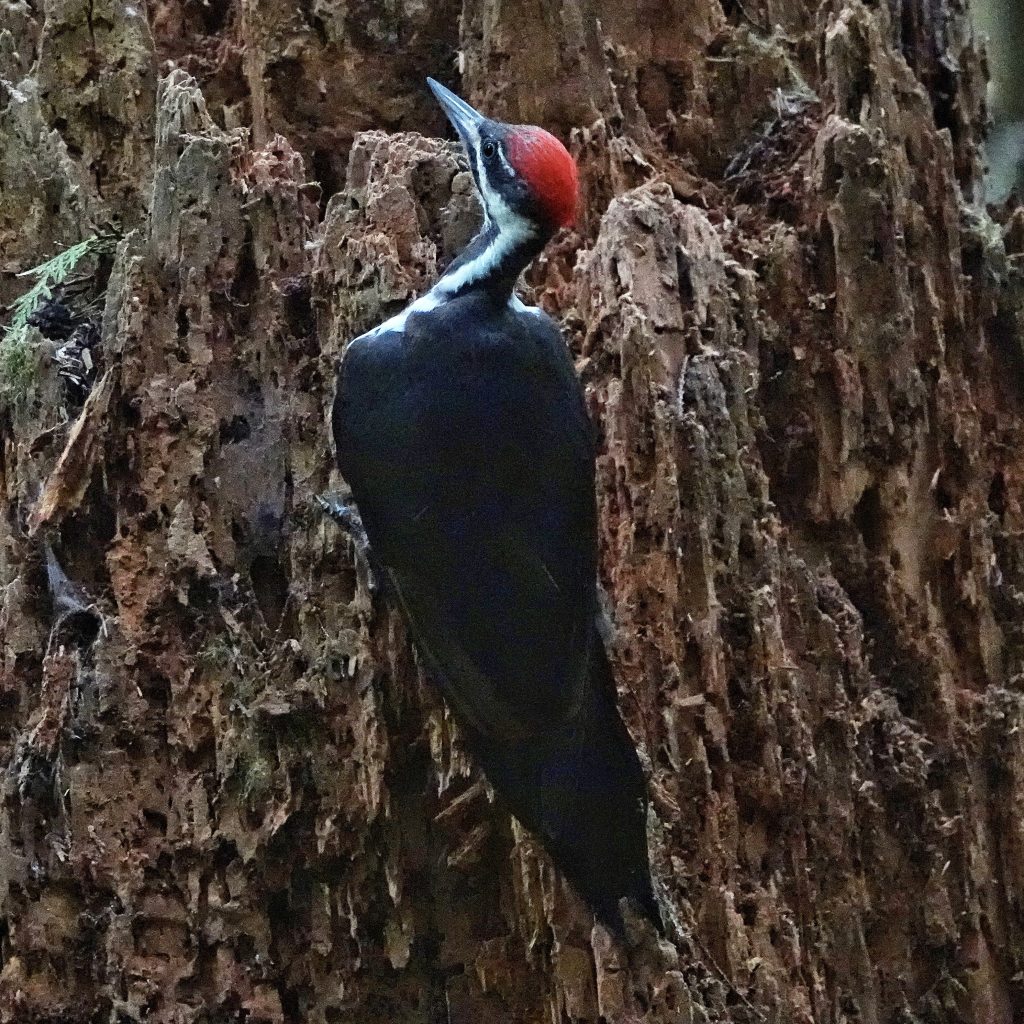
Pileated Woodpeckers (and woodpeckers in general) play vital roles in the health of a forest. They help regulate the insect population so it doesn’t get out of control, and help introduce the fungi that are essential to the decomposition of dead trees. And their abandoned nests and feeding excavations provide shelter and nesting spots for birds like owls and wood ducks which are incapable of drilling their own, as well as shelter and food access for wrens, chickadees, kinglets and other small birds. Mammals like squirrels and raccoons also utilize the holes for shelter.
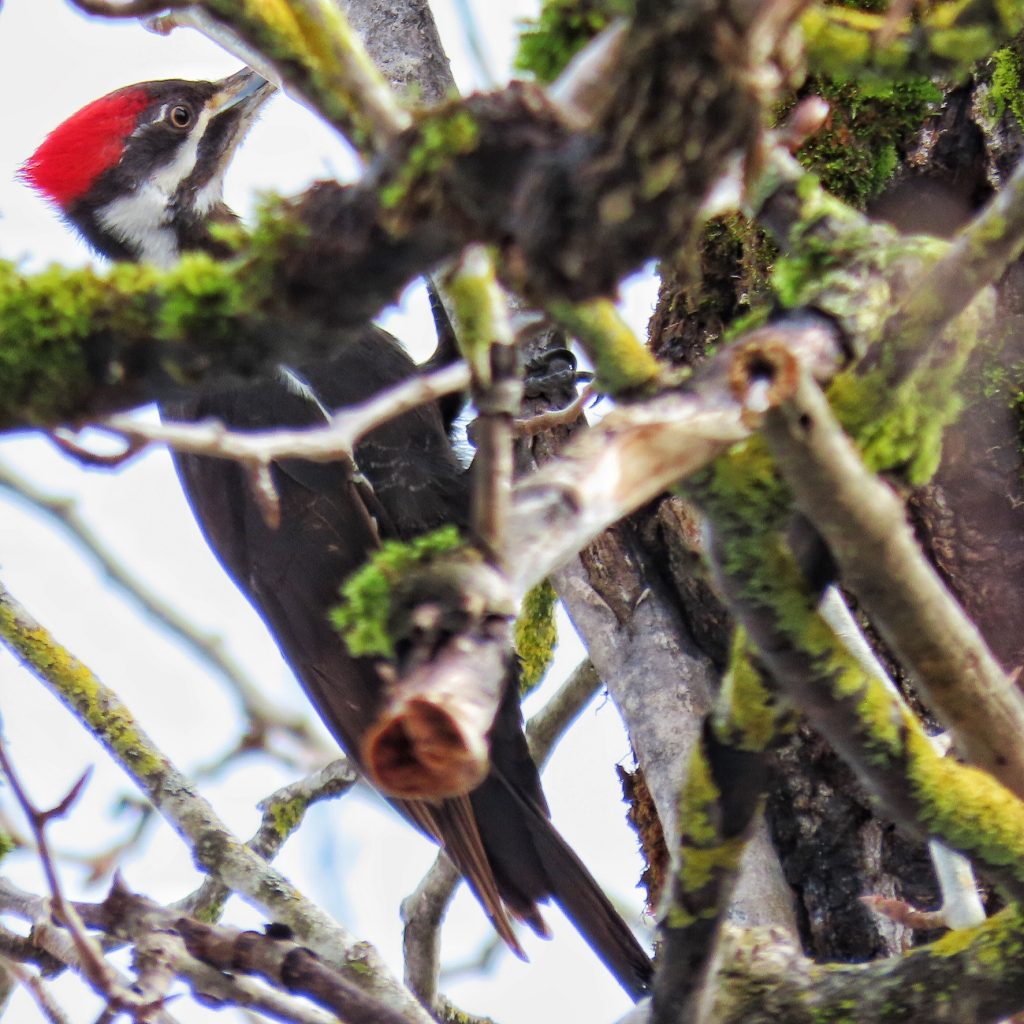
Description– Large (16-19” tall), mostly black woodpecker with a triangular, black, white, and red head, with a bright red, crested cap; males have a red ‘moustache’ (malar patch), while that of females is black, although the red of the males is much darker than the cap of either sex, and a color blind guy like me can’t usually tell the difference; large white patches on underside of the wings are distinctive in flight, as are the white wingbars on the top of the wings.
Similar species– All other woodpeckers in our region are significantly smaller, and lack the combination of a long, relatively narrow neck leading to a triangular, red-capped head.
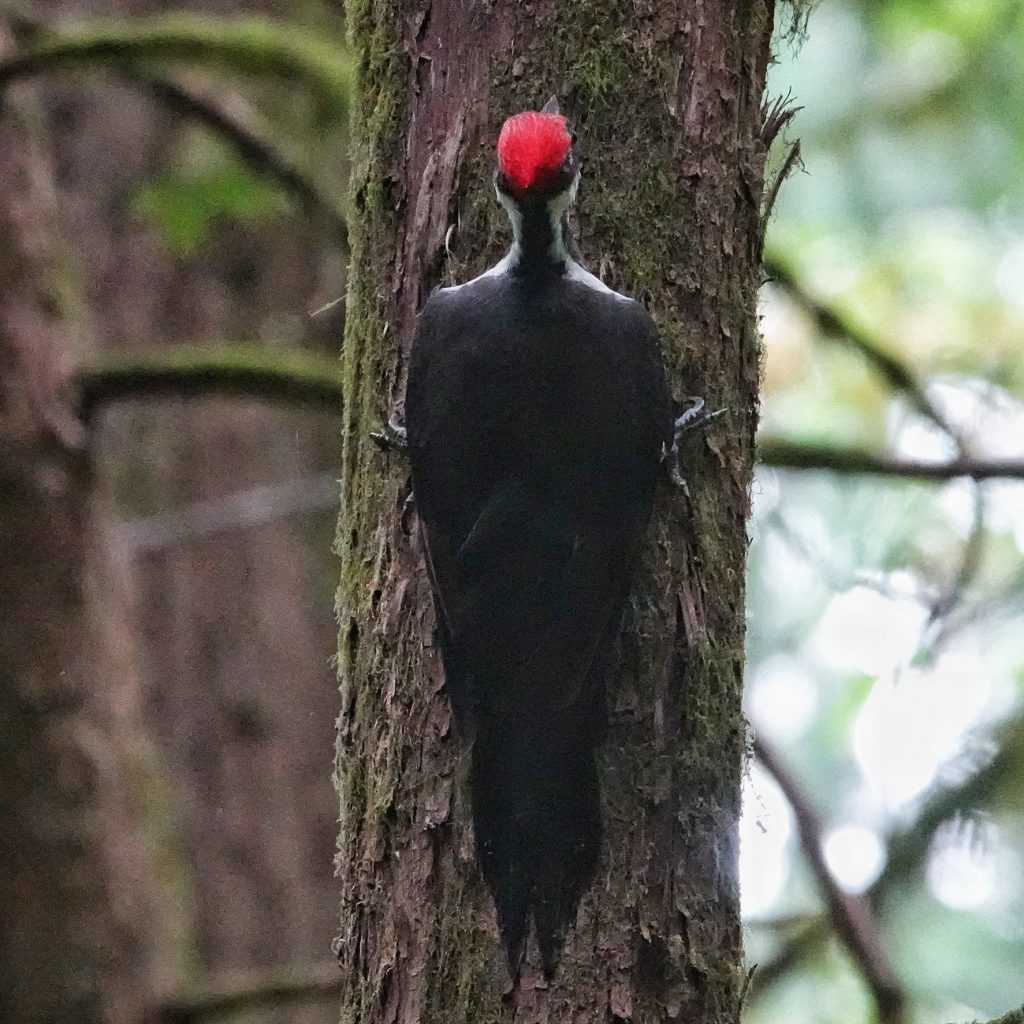
Habitat-Wooded and forested areas with large trees and snags.
Range– Temperate North America, but absent in the Great Plains and sw USA; region wide in appropriate habitat, except absent from juniper forests and isolated pine/aspen woodlands.
Adults active-Year around
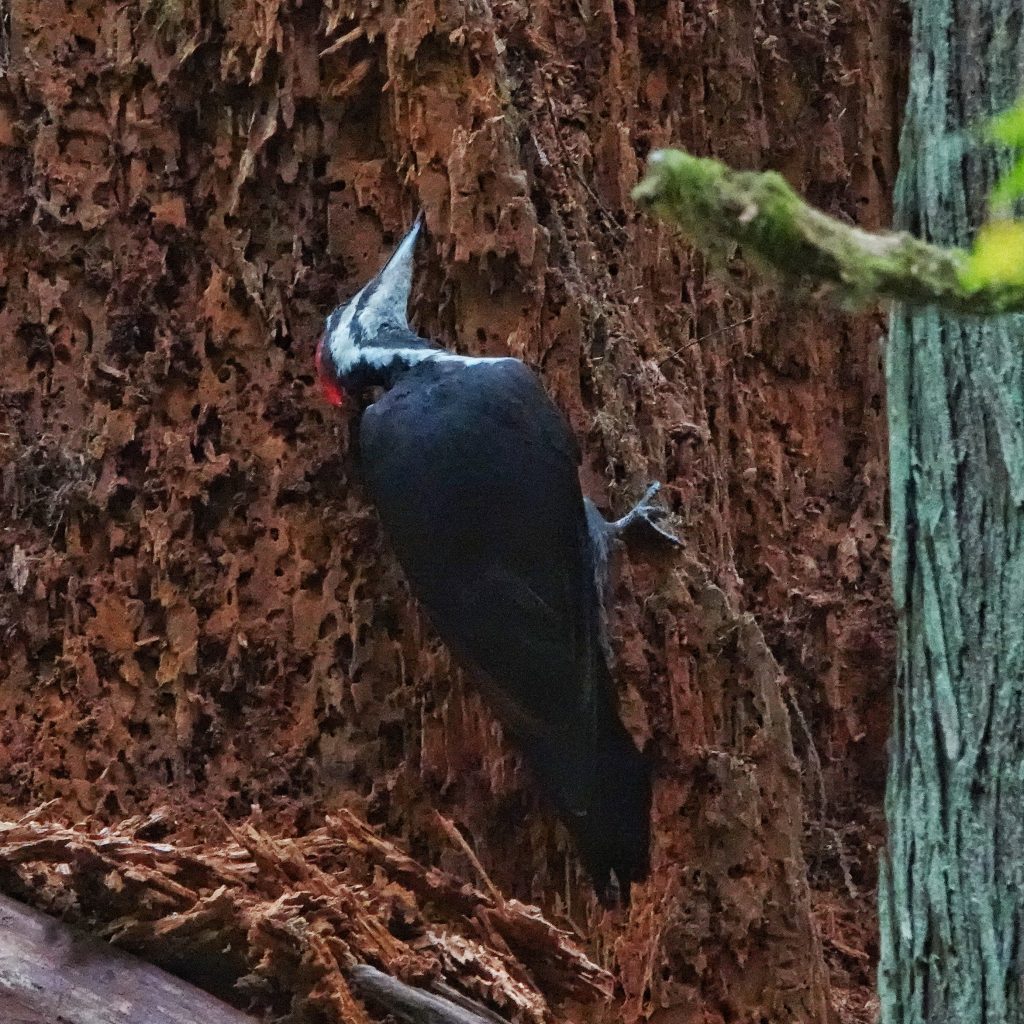
Eats– Drills oblong to rectangular holes in search of ants (especially carpenter ants), beetle larvae and other insects and their larvae, and will glean from branches and prise bark from the tree to find invertebrates; also will eat fruit, nuts, and sap, mostly in fall and winter.
Eaten by– Adults don’t have many predators, although they may be preyed upon by various hawks and owls, but the young are taken by most carnivores that can get to them, including owls, hawks, marten, weasels, squirrels, arboreal snakes, and even coyotes, foxes, and bobcats.
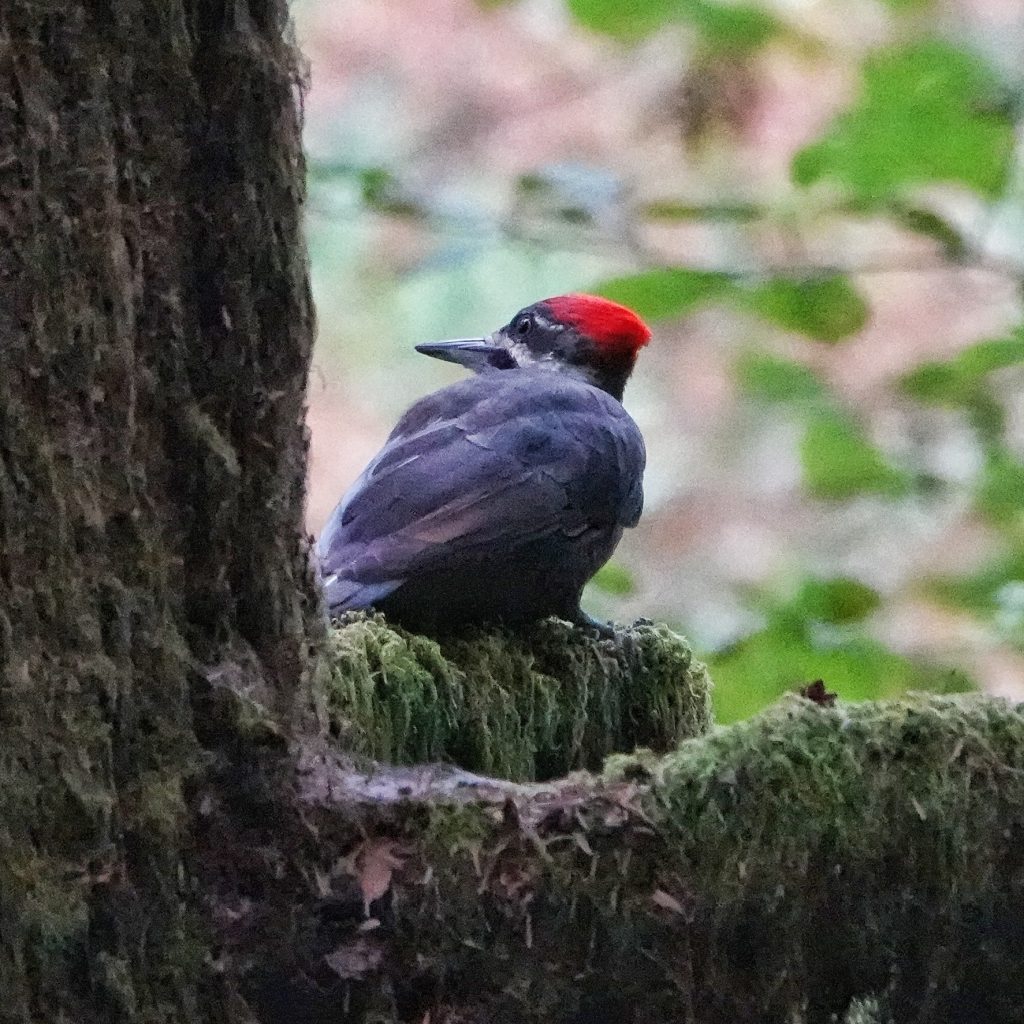
Life cycle– Males and females work together to excavate a rectangular hole that is 3-4” wide and up to 2’ deep, fairly high in a tree, usually a snag or one in some state of decomposition (although redwood trees are soft enough to be excavated while still green), often facing south or east; seem to prefer conifers, but will nest in aspens, cottonwoods, and a variety of other trees; nests are lined with wood chips, and are only used once; 3-5 eggs are incubated for 15-18 days, hatch in mid to late spring, and altricial young fledge in about 4 months; adults continue to care for young for several more months; may live for up to 12 years.
Etymology of names– Dryocopus is from the Greek words for ‘tree’ and ‘beating’, and the combination was the Ancient Greek word for woodpecker. The specific epithet pileatus is from the Greek word for ‘capped’, and refers to the prominent red crest.
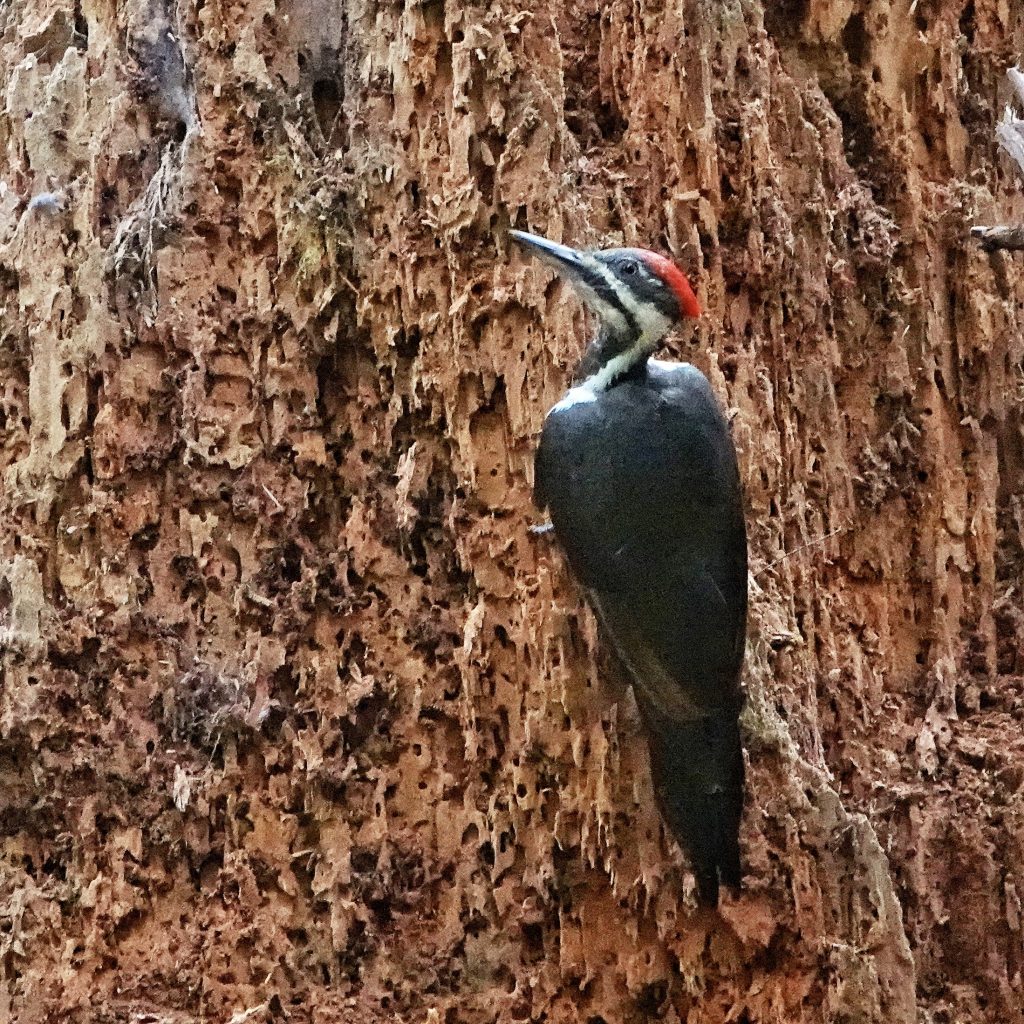
Pileated Woodpecker Overview, All About Birds, Cornell Lab of Ornithology
Why woodpeckers can hammer without getting headaches – BirdWatching
Meet the Large, Red Crowned Pileated Woodpecker
10 Fun Facts About the Pileated Woodpecker | Audubon
Pileated Woodpecker (U.S. National Park Service)
Pileated Woodpecker | Audubon Guide to North American Birds
ADW: Dryocopus pileatus: INFORMATION
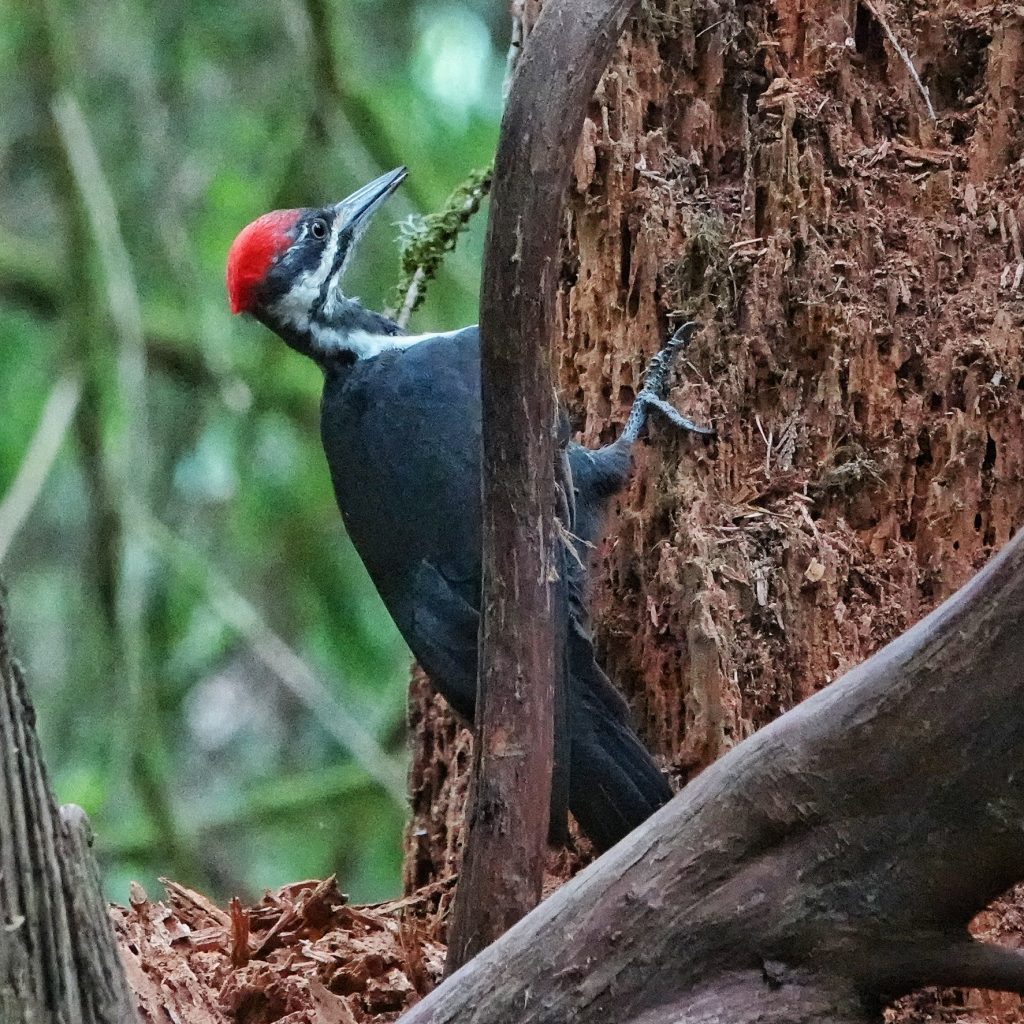
I’m just calling them capped tree beaters from now on.
I bet people will still know exactly what bird I’m talking about. It just fits.
Great idea, Kat!
But there are several capped tree beaters! 😉
Thanks for the article! They are amazing birds. They sorta remind me pterodactyls!
Yes, they are kinda prehistoric, K!
I wrote a paper in graduate school about carpenter ants – from an alternate perspective of how humans view them (as pests). One study I read found that 85% of the diet of Pileated Woodpeckers is comprised of carpenter ants. That’s a lot! While it will be a struggle to get folks to change their minds about applying bait for ants, I would highly encourage anyone stuck in this mindset to consider that many of the species we see as pests are food for other organisms. When you put out bait, the bait is carried back to the main ant colony – usually in the forest somewhere. We just don’t see the impacts. More can be found in – Bull, E. L., Beckwith, R. C., & Holthausen, R. S. (1992). Arthropod Diet of Pileated Woodpeckers in Northeastern Oregon. Northwestern Naturalist, 73(2), 42–45. https://doi.org/10.2307/3536688
Good information and good advice, Cynthia!